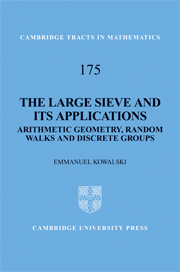Book contents
- Frontmatter
- Contents
- Preface
- Acknowledgments
- Prerequisites and notation
- 1 Introduction
- 2 The principle of the large sieve
- 3 Group and conjugacy sieves
- 4 Elementary and classical examples
- 5 Degrees of representations of finite groups
- 6 Probabilistic sieves
- 7 Sieving in discrete groups
- 8 Sieving for Frobenius over finite fields
- Appendix A Small sieves
- Appendix B Local density computations over finite fields
- Appendix C Representation theory
- Appendix D Property (T) and Property (τ)
- Appendix E Linear algebraic groups
- Appendix F Probability theory and random walks
- Appendix G Sums of multiplicative functions
- Appendix H Topology
- References
- Index
7 - Sieving in discrete groups
Published online by Cambridge University Press: 05 October 2009
- Frontmatter
- Contents
- Preface
- Acknowledgments
- Prerequisites and notation
- 1 Introduction
- 2 The principle of the large sieve
- 3 Group and conjugacy sieves
- 4 Elementary and classical examples
- 5 Degrees of representations of finite groups
- 6 Probabilistic sieves
- 7 Sieving in discrete groups
- 8 Sieving for Frobenius over finite fields
- Appendix A Small sieves
- Appendix B Local density computations over finite fields
- Appendix C Representation theory
- Appendix D Property (T) and Property (τ)
- Appendix E Linear algebraic groups
- Appendix F Probability theory and random walks
- Appendix G Sums of multiplicative functions
- Appendix H Topology
- References
- Index
Summary
Introduction
This chapter, which may be the most innovative in this book, reflects the outcome of a number of different important mathematical ideas. Most of them are related to number theory, but as we will see, both the tools involved in making the sieve apply and its potential applications go far beyond.
The basic motivation is that any discrete set with interesting structure can be investigated by ideas that are related to sieve. The object we consider here, for the most part, is a discrete finitely generated group G (see the last remark in this introductory section for some words on another variant arising from the ongoing work of Bourgain, Gamburd and Sarnak). Of course, the simplest such group is undoubtedly Z, which recovers the classical sieve setting. If we stick to groups with an arithmetic flavour, it seems natural, however, to consider for instance the modular group SL(2, Z), which intervenes prominently in both analytic and algebraic number theory, and then more generally SL(n, Z), n ≥ 2, or Sp(2g, Z), g ≥ 1. For each of these groups, there is an obvious reduction map ρℓ modulo a prime ℓ, with image a finite group, which is indeed a finite group of Lie type (such as were considered in Chapter 5), and this gives a sieve setting (G, {primes}, (ρℓ)). In fact, any ‘arithmetic group’ is a natural target for sieving but, for simplicity, we will keep to the most concrete cases.
Information
- Type
- Chapter
- Information
- The Large Sieve and its ApplicationsArithmetic Geometry, Random Walks and Discrete Groups, pp. 101 - 153Publisher: Cambridge University PressPrint publication year: 2008
